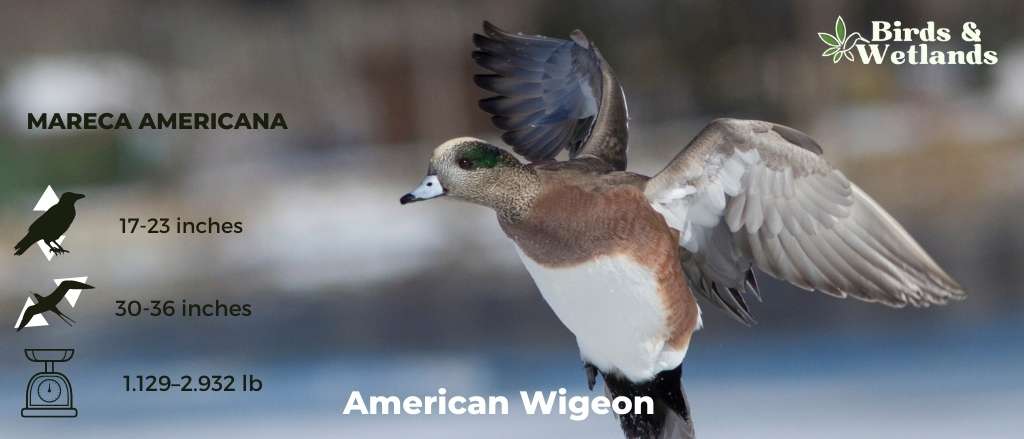The American wigeon is a medium-sized duck native to North America. It is also known as the baldplate due to the white crown or white stripe of the male duck that resembles a bald man’s head. As a New World counterpart of the Eurasian wigeon, it is a member of the genus Mareca.
American wigeon is a dabbling duck, which means it feeds on the water’s surface by tipping its head down and dipping its bill into the water like most dabblers.
Scientific Name: Mareca americana
Height: 42–59 cm (17–23 in)
Wingspan: 76–91 cm (30–36 in)
Weight: 512–1,330 g (1.129–2.932 lb)
American Wigeon Description
Male American wigeons in breeding plumage are a beautiful sight. They have a round head, greyish-brown upper parts with contrasting white wing coverts visible in flight. They have an iridescent green band stretching from the eye to the back of the head.
In addition, they have a white patch on the rear portion of the flanks, as well as white underparts. However, the true beauty of these birds lies in their black undertail-coverts and vents, which contrast sharply with their pale gray underwings.
The lesser coverts and flight feathers are darker than the axillaries, but the white median wing coverts really stand out.
Male American wigeons also have a white forehead, a central crown, and a dark green band that extends from the eye to the nape. The sides of both the head and neck are greyish, but this only adds to their overall look.
Finally, males have a pale bluish-grey bill with a black tip, brown eyes surrounded by a dark area, and dark gray legs and feet.
Adult female American wigeons have mostly brown plumage with some gray mottling and a gray wing patch. They have a brownish-black crown, barred white, and black uppertail converts, and their tails are black with white edges.
Their bellies are white and have a black smudge around the eye. Their bills are grayish-blue with a black tip, and their legs and feet are blue-gray.
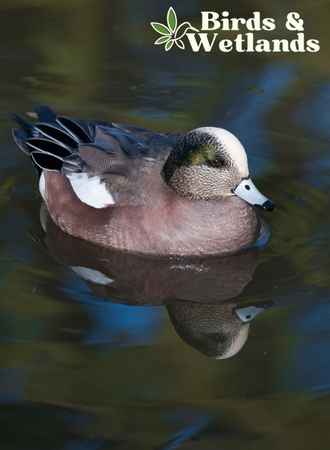
Listen to American Wigeon
American Wigeon Habitat & Range
American wigeons breed in a wide variety of habitats across northwestern North America. Their breeding grounds are wet meadows, marshes, and ponds from Alaska to the Great Plains.
During the summer, they move to higher elevations in the Rocky Mountains, while some birds remain year-round in coastal areas.
Their preferred breeding habitat is a wetland with plenty of aquatic plants for nesting material, such as sedges, rushes, and grasses.
American wigeons are not particularly picky about where they nest and will even use man-made structures such as nest boxes if no suitable natural sites are available.
Wigeons from Alaska and western Canada use the Pacific flyway to reach their wintering grounds around Puget Sound and California. Birds travelling the Central Flyway spend winters in the Texas Panhandle and along the Gulf Coast.
Moreover, some birds of this species travel further south of their breeding range and into central Mexico, Central America, northern South America and the Caribbean. It is a regular vagrant in Great Britain and Ireland.

American Wigeon Diet & Food Habits
The American wigeon is a dabbling duck that primarily feeds on aquatic plants. It is found in marshy sloughs, lakes and ponds with other dabblers. It eats more plant materials than any other dabbling duck.
The American wigeon’s diet consists primarily of aquatic plant stems, leaves, and seeds. It uses its short bill to pluck vegetation and eat insects, crustaceans, and mollusks. But its diet may change in the winter and include waste grains and seeds.
Although not diving ducks, most older birds will occasionally submerge their heads and bodies in the water to forage food. They spend more time in deep water than other dabbling ducks. Additionally, these waterfowl have a peculiar habit of following other ducks to steal food from them.
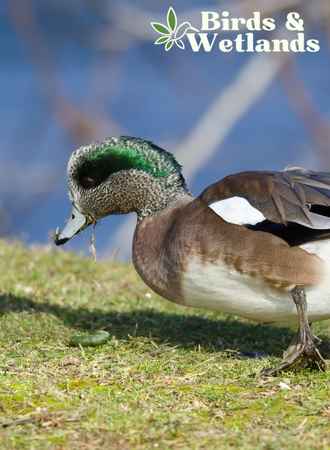
American Wigeon Nesting & Mating Habits
The American wigeon is a migratory bird that nests in North America’s northern regions. Its breeding season typically starts in May.
During spring migration, the male performs a flight display in which he circles high in the air and then dives steeply toward the ground, honking loudly. This behavior is believed to impress potential mates and assert dominance over other males.
After forming a pair, the male and female wigeon will defend their territory and nest site from predators.
Like most ducks, the female chooses the nesting site, which is usually on dry land hidden among dense vegetation and close to the water. The nest is a shallow depression on the ground made from plant stems, leaves and grass. She lines the nest with her own down feathers.
Upon mating, she will lay 7 to 10 creamy white eggs that she incubates for 23 to 25 days. The male abandons the female before the eggs hatch, leaving her to tend their young.
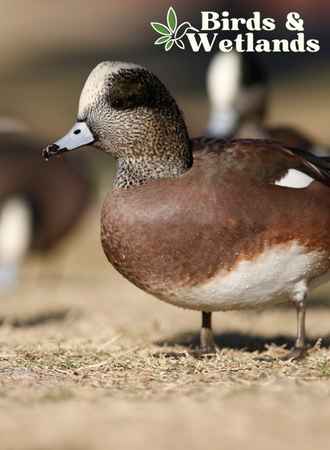
American Wigeon Population & Conservation Status
The American wigeon has a healthy North American population and is currently considered “Least Concern” by the IUCN.
American Wigeon Hunting
American wigeons are popular game birds and among the most harvested waterfowl in the country. Hunting season, daily bag and possession limits vary from state to state, so check waterfowl hunting regulations before heading out.
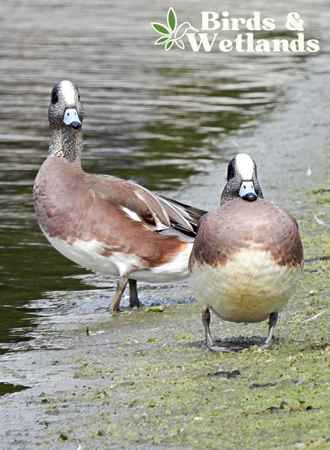
Key Points
- American wigeons are dabbling ducks that prefer freshwater wetlands and slow-moving rivers.
- The nest is a shallow depression filled with soft plant material and down on the dry ground.
- These ducks eat a higher proportion of plant matter than other dabbling ducks.
- Males have white patches on the sides of the rump.
- Males leave females during the incubation period. Some may stay until incubation begins.

